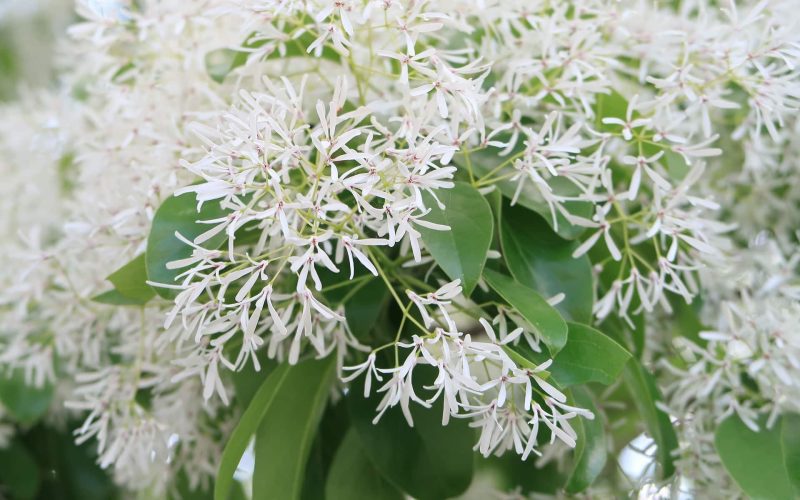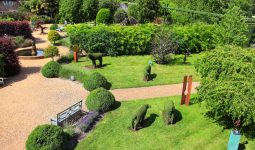Looking great and hassle-free? Think low maintenance shrubs! Shrubs serve as the bedrock of garden design, and while some dazzle with their flowers and brilliant colors, others fill the air with a heavenly scent.
However, not everyone has the time to maintain these beauties all year round. This is where low maintenance shrubs come in. They’re attractive and problem free.
Also, they don’t require continual pruning or maintenance, and none have significant pest issues. Here are 25 low maintenance shrubs that will provide maximum beauty and give your garden a facelift. Let’s go!
1. Inkberry Holly
This native North American broadleaf evergreen is an excellent foundation plant. The lustrous, dark-green leaves cling to the branches all year long. Dark blue berries appear after unremarkable spring blossoms.
Inkberries grow to a height and spread of 5 to 8 feet, thriving in full sun to partial shade. They are flexible, and, like all hollies, the plants can be either female or male.
You must plant one male shrub for every five female shrubs in order to see the berries. Although they typically don’t require any pruning unless you’re growing them as a hedge, it’s ideal for pruning them in the early spring.
2. Goldthread Cypress
Modern landscaping typically features these evergreen, low-maintenance shrubs. Their yellow-green needles are attractive all year.
The semi-dwarf goldthread cypress is an evergreen shrub with a natural cone shape that is hardy to -30 degrees Fahrenheit. It has thread-like, golden branches that weep and inhibit growth.
This cultivar slowly grows 15 to 20 feet tall but can be pruned to remain more compact, unlike its original species, which can reach heights of 50 feet or more in its native Asian area.
Although it thrives in direct sunlight, it can take some shade; however, the growth will be sparser. This shrub requires no pruning due to its natural growth pattern.
3. Rockspray Cotoneaster
Rockspray is an excellent choice if you’re searching for low-maintenance, low-growing shrubs. The Asian native rockspray cotoneaster can withstand temperatures of -20 degrees Fahrenheit, stays low to the ground (2 to 3 feet tall), and spreads widely.
The blossoms appear in the spring, and spectacular red berries follow. It takes minimal trimming and is a highly adaptable plant that tolerates dryness and poor soils. It branches horizontally and grows slowly. It’s semi-evergreen, where it grows in the south. Birds find the berries to be appealing.
4. Beautyberry
The American beautyberry offers so many attractions! These pest-free low maintenance shrubs have a magnificent arching appearance and require little to no pruning.
Beautyberries are US natives that can withstand temperatures as low as -20 degrees Fahrenheit and grow 3 to 6 feet tall and wide. The bright purple berries that linger long into the winter and draw birds put on a magnificent display after the little pink blossoms.
The best condition is full sun to some shade. The plant may die back to the ground in winter in northern growing regions, but since the flowers and berries are made on fresh wood, the plant will flower later in the same season.
5. Possumhaw
Possumhaw is a fantastic option if you’re seeking low-maintenance shrubs with fall and winter interest. It is a deciduous shrub that blooms in April and May and is prized for its stunning fall berries, which range in color from deep pink to blue and can appear simultaneously.
This shrub attracts birds and pollinators and thrives in full sun to light shade. Possumhaw is a tough tree that can withstand temperatures as low as -20 degrees Fahrenheit. It can grow from 5 to 12 feet tall with an equal spread, has few pests, and needs very little pruning.
6. Maejima Daphne
Daphnes are famous for their incredible fragrance, and this variety is no exception. A winter bloomer that is evergreen and reliable, it has rose-pink flower clusters and variegated leaves.
Being only hardy to 0 degrees F, it does best in warm areas. The Maejima daphne is a cultivar of an Asian and European native that grows to a maximum height of only three feet. Minimal trimming is necessary for this plant.
7. Chinese Paperbush
Paperbush is a stunning winter-blooming shrub that blooms from February through April with rounded clusters of bright yellow flowers. The plant grows to a height and spread of 4 to 6 feet and can withstand full sun to moderate shade.
These low maintenance shrubs are in high demand due to their showy winter appeal. Paperbush is only hardy to 0 degrees Fahrenheit, so keep it in a safe area where it may get some shade during the hot summers.
8. Vernal Witch Hazel
Witch hazels are incredibly cool, low-maintenance plants that bloom at various times depending on the species and hybrids. Vernal witch hazels are native to North America; they have a lovely spicy scent, and their golden, thread-like petals stand out on bare twigs. It also has beautiful fall foliage colors. They can withstand temperatures of -30°F and grow to a height of 6–10 feet.
9. Bottlebrush Buckeye
The bottlebrush buckeye is a deciduous shrub found in the southeastern United States. It grows beautifully as a specimen or hedge plant and is easily hardy to -20 degrees Fahrenheit.
These low maintenance shrubs bloom in their full splendor in June and July, with a wide spreading range of 8 to 15 feet and a height of 8 to 12 feet. White flower spires that are upright and 12 inches or longer in length soar above the foliage in a stunning display.
There are no widespread insect or disease problems with the plant. The best time to prune this plant is right after it blooms; however, no pruning is preferred.
10. Annabelle Hydrangea
One of the most consistent bloomers in the hydrangea world is the deciduous shrub known as Annabelle. This native of North America, often known as a smooth hydrangea, can withstand temperatures of -40 degrees Fahrenheit.
It blooms from June through September, producing huge, foot-wide balls of white flowers that turn light pink or green as the season progresses. There is no need to worry about the buds freezing out because Annabelle blooms on new wood. Pruning should happen in the early or late spring.
To encourage proper plant shape, trim the plant back to a height of 12 to 18 inches. Annabelle grows to a height of 3 to 4 feet and a spread that is a little wider than that. It tolerates both wet and dry soil. The plant does best in partial shade because it wilts in full sun.
11. Shrub Roses
There are several varieties of shrub roses that are regarded as low maintenance shrubs. Most shrub roses bloom continuously and grow to a height of between 3 and 4 feet with an equal spread.
Trade names, such as the well-known Knock Out series. Others are unique species, such as rugosa roses (Rosa rugosa).
All shrub roses are resilient, require little maintenance, and bloom profusely. Most are resistant to pests and diseases and bloom in the summer.
Although some only need three to four hours of sunlight, shrub roses prefer full sun. Although it’s preferable to prune in the spring, picking off the dried-up blooms as they appear will also help the plant produce more blooms.
12. Summersweet Clethra
These low-maintenance shrubs are native to the Eastern US and are deciduous. They can withstand temperatures as low as -30 degrees Fahrenheit and grow 3 to 8 feet tall with a spread of 4 to 6 feet.
In July and August, upright, slender panicles with white to pink blooms emerge. Summersweet clethra grows in full sun to partial shade and can handle both regular and moist soils.
If pruning is necessary, do it toward the end of winter. The thick branches are covered in blossoms that attract butterflies and bees. This is an excellent option for shade if you desire summer shade.
13. Oakleaf Hydrangea
The oakleaf hydrangea is a native deciduous shrub to the Southeast of the United States and one of the easiest-care, low-maintenance plants for gardeners. It blooms in early summer with huge, cone-shaped clusters of white flowers that later turn pink.
The height ranges from 6 to 8 feet, with an equal spread. Oakleaf hydrangeas are quite showy and grow well in full sun and shade.
The big oak-leaf-shaped leaves change to stunning colors of orange, red, and purple in the autumn. It thrives in damp soils, but regular garden soil will also work. Only prune right after blooming, though it is advised not to prune at all.
14. Japanese Spirea
Japanese spirea is a deciduous native to Asia that can withstand temperatures as low as –40°F. It has a maximum height of 4 to 6 feet and a maximum spread of 5 to 7 feet. In the full sun of June and July, flat-topped clusters of pink blossoms appear.
Butterfly and other pollinator visitors are drawn to these low-maintenance shrubs. In order to get a second flush of flowers, prune the plant back right after it blooms.
Every few years, this shrub can be cut all the way back to the ground for heavier pruning, preserving the plant’s lovely shape. Heavier pruning should take place in late winter to early spring.
15. Virginia Sweetspire
Sweetspire blooms in May, and June is hardy to -20 degrees Fahrenheit and grows to a height of 3 to 5 feet with an equal spread. The shrub is covered with panicles of white blooms that hang from the flowers.
Sweetspire prefers direct sunlight to light shade. It is ideal for pruning these low-maintenance shrubs in late spring or early summer, right after they have completed blooming. Sweetspire is a low maintenance shrub ideal for low-lying locations or rain gardens since it tolerates “wet feet.”
Sweetspire flowers have a pleasant scent, and the foliage becomes a stunning shade of red in the autumn. It has a rounded growth habit, arched branches, and no pest or disease issues.
16. Smokebush
The incredible smokebush shrub can withstand temperatures as low as –20 degrees Fahrenheit. It has an equal spread and rises between 10 and 15 feet.
These low-maintenance shrubs get their common name from their appearance, which is frothy and smoke-like. Sunlight should be full to partial.
Depending on the cultivar, the leaf can be either wine-red or bluish-green in color. Although smokebush is resistant to deer, you should avoid soils with poor drainage.
17. Dwarf Korean Lilac
This lovely, low-maintenance deciduous shrub has a maximum height of 4 to 5 feet and a spread of 5 to 7 feet. It attracts hummingbirds and butterflies to the clusters of light pink to purple flowers that bloom in April, May, and June. Although Korean lilacs can tolerate some shade, the full sun produces the best flowering.
If pruning is necessary at all, do so right away after flowering. Deadheading the fallen flowers keeps the plant looking tidy and may enhance flowering the following year.
18. Weigela
Weigela is a native of China that is deciduous and prized for its abundant blooms and easy maintenance. It grows to a height of 6 to 10 feet and a spread of 9 to 12 feet. It is hardy to -30 degrees Fahrenheit.
These low maintenance shrubs have pink tubular blooms, which attract hummingbirds. Weigelas should be pruned as soon as the plant has completed flowering because they blossom on branches from the previous season. It prefers full sun but may also grow in partial shade.
It is amazingly free of pests and diseases. Some cultivars have variegated or wine-red leaves. Little to no pruning is necessary because the mature shrubs have a lovely arching growth habit.
19. Fountain Butterfly Bush
Fountain butterfly bush blooms in the spring with clusters of lilac flowers on stalks that arch beautifully. The slender plant can reach heights and widths of ten feet. Use the shrub in a mixed shrub border or as an accent plant.
It can withstand drought and enjoys a sunny setting in any well-drained soil. In the coldest areas of its natural range, it dies back to the ground but then resprouts and blooms on fresh wood. This plant is among the low maintenance shrubs you can add to your garden.
20. Korean Spice Viburnum
Korean spice viburnum produces intensely fragrant white flowers in the spring that emerge from pink buds. Blue-black fruit appears in the early summer.
The shrub is 4 to 8 feet tall and has upright, spreading branches up to 8 feet wide. To benefit from its tempting scent, place this dense, rounded shrub near paths and entranceways or use it as a foundation plant. Ensure to provide slightly acidic, well-drained soil in full or partial sun.
21. Loropetalum
The tidy plant loropetalum has delicate elegance in its arching, tiered branches, and spidery spring flowers that are either white or pink. It can grow 3 to 10 feet tall and just as wide, depending on the variety.
You can plant these low maintenance shrubs in woodland gardens and foregrounds. It favors partial shade inland and bright sun in foggy coastal locations. Hardy from 0° to 10°, evergreen.
22. Black Chokeberry
Black chokeberry is a hardy, 3- to 5-foot-tall shrub with small, white, or pinkish blooms and shiny, black 1/2-inch fruits. The vibrant red-purple color of fall lasts for several weeks.
This leggy shrub is ideal for background plantings or as a filler. In addition, this widely adapted plant can survive in a wide range of soil conditions, exposures, and water regimes. It is hardy to -40 degrees and deciduous.
23. India Hawthorn
The India hawthorn is a compact, rounded shrub with glossy, leathery leaves and abundant flowers that bloom from late fall or midwinter to late spring. Also, its among low maintenance shrubs and its flowers range in color from white to pink.
In addition, the plant spreads slightly wider and grows 3 to 4 feet tall. This flower thrives in average, well-drained soil in full sun. However, in coastal areas, it can withstand drought and salt spray. They’re hardy to 10° and evergreen.
24. Texas Ranger
Texas rangers can handle desert winds, heat, and drought. These low maintenance shrubs have a height of 5 to 8 feet and a width of 3 to 5 feet.
Purple bell-shaped flowers provide a nice touch to the silvery or green leaves in warmer weather. You can use this shrub as a screen, on slopes, or in rock gardens. It requires no additional water and thrives best in direct sunlight. Hardy to 5°, evergreen to partly deciduous.
25. Japanese Barberry
Japanese barberry has arched, prickly branches and is strong yet graceful. Plants have an equal spread and grow to a height of 4 to 6 feet. Deep green, small leaves change color in the fall to yellow, orange, and red.
Use it as an accent or to create informal hedges, barriers, and borders. The most vibrant foliage requires full sun but can tolerate light shade. It can withstand extremes in soil and climate.
Conclusion
These are the low maintenance shrubs we have for you on this list. Consider the shrubs available in your area and select ones that maintain lush foliage from top to bottom. We hope that you find a perfect one for your landscape. Thanks for reading!








